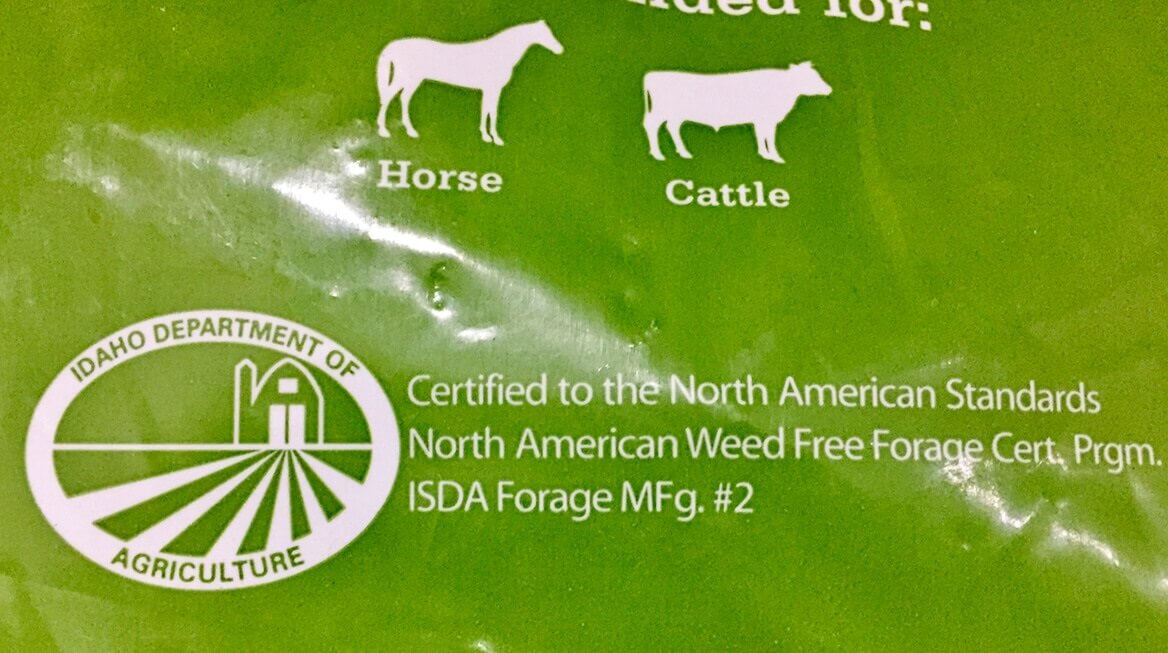Responsible Options for Happy Horses and Healthy Trails
You’ve probably come across terms like “weed-free feed” or “certified weed-free forage” when feeding your horses and mules. Whether it’s a requirement or only recommended in the areas where you ride, it’s essential to understand what these feeds are, and which ones meet the necessary criteria. Let’s dive into why weed-free feed is important, its role in combating invasive species, and how it keeps you out of trouble with the authorities while ensuring your animal’s well-being during your outdoor escapades.
The Impact of Invasive Species: Invasive species are a serious concern in the 21st century, and they’ve made their way into all 50 states. Their economic impact is estimated to be a staggering $138 billion annually. As a result, federal and state agencies have taken a firm stance against them, which unfortunately affects recreational stock users like us. Despite studies showing that stock use has a minimal chance of spreading noxious weeds, strict laws have been implemented. Violating these rules can result in hefty fines of up to $10,000 or a cozy jail cell for six months.
Research and Compliance: To avoid having an enjoyable camping trip cut short by an unexpected fine, doing your homework before leaving home is crucial. Look into the requirements of the area where you plan to ride and ensure you understand how to comply. Many National Forests, BLM areas, and National Parks on the west coast require some form of weed-free certification. Even some state parks have adopted it for their areas. Check out the agency’s website for specific rules and regulations for your chosen location.

Types of Weed-Free Feed: Several types of feed meet the certification requirements. The North American Weed Management Association (NAWMA) has established standards for unprocessed hay (forage) and processed feeds such as cubes and pellets. Let’s explore the advantages and disadvantages of each option so that you can make an informed decision based on your preferences and the needs of your animals.
1. Certified Noxious Weed Seed-Free Hay: This type of hay is certified as free from noxious weed seeds. Look for bales with tags or unique color twine indicating that the state agriculture department has inspected their origins. Unprocessed hay has the benefit of longer fiber length, which keeps your animals’ digestive systems busy and warm during chilly weather. The downside? It can be heavy and bulky to transport.
2. Certified Weed-Free Hay Cubes and Pellets: These feeds are made by chopping, grinding, and pressure treating hay. Look for bags labeled with certification tags indicating compliance with the North American Weed-Free Forage Certification Program. Cubes and pellets offer less waste, easier packing and transportation, and increased digestibility compared to baled hay. Plus, a 50-pound bag of pellets can last as long as a 60- or 70-pound hay bale. Talk about convenience!
3. Commercially Processed Feed Pellets or Rolled Grains: These feeds are finely ground, heat-treated, and compressed into pellets. They provide a complete diet by balancing ground hay with grains for energy, vitamins, and minerals. The best part? You won’t need to pack additional supplements since the feed’s nutrient content is guaranteed.
Choosing the Best Option: Now that you know the options, it’s time to select the feed that suits you best. Some riders prefer the familiarity of unprocessed forage, while others mix it up using a combination of hay, cubed hay, and commercially processed feed for a balanced diet. Whichever route you take, keep the certification tags or certificates with the feed in case a ranger or land manager wants to verify them. And keep in mind, if you’re transitioning your horse’s diet, do it gradually to minimize the risk of colic and allow them to adjust comfortably at home before your adventure begins. Also, horses consuming pellets or cubes may need more water, and there’s a slightly increased risk of choking.
Feeding certified weed-free feed isn’t just about following regulations—it’s about being responsible, conserving nature, and ensuring the well-being of your animals. By understanding the importance of preventing the spread of invasive species and making informed choices about weed-free feed options, you can have a fantastic time on the trails while minimizing your environmental impact.
For more information on trail riding and camping with livestock, as well as the world’s largest guide to horse trails and camps, visit www.TrailMeister.com.
See this article in the November/December 2023 online edition:
November/December 2023

Robert Eversole, ”the trail meister,” owns www.TrailMeister.com, the largest database of horse riding and camping areas in the U.S. with free trail and trailhead information, trail maps, and much more to help horse enthusiasts experience the joys of trail riding. Robert is a registered riding instructor with PATH International, a mounted search and rescue team member, and a U.S. Marine who has served on the board of the Backcountry Horsemen of Washington (BCHW). He is enjoying his new career helping fellow trail riders stay found and safe on the trail. When not on the trail, The Trail Meister resides near Spokane, WA and teaches land navigation to a wide variety of outdoor groups across the nation. For North America’s largest horse trail and camping directory, trail tips, and more, visit www.TrailMeister.com.





